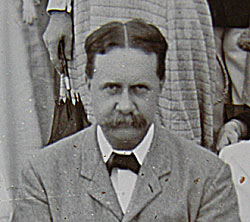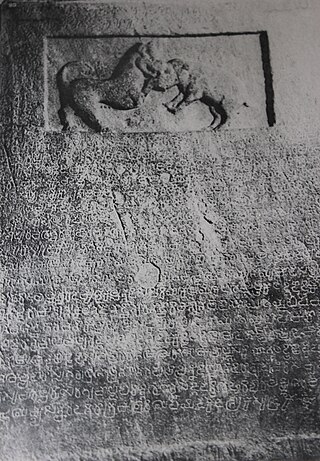
The Archaeological Survey of India (ASI) is an Indian government agency that is responsible for archaeological research and the conservation and preservation of cultural historical monuments in the country. It was founded in 1861 by Alexander Cunningham during the British Raj who also became its first Director-General.

The Hathigumpha Inscription is a seventeen line inscription in a Prakrit language incised in Brahmi script in a cavern called Hathigumpha in Udayagiri hills, near Bhubaneswar in Odisha, India. Dated between the second century BCE and the first century CE, it was inscribed by the Jain king Kharavela of the Kalinga kingdom.

Sir Richard Carnac Temple, 2nd Baronet, was an Indian-born British administrator and the Chief Commissioner of the Andaman and Nicobar Islands and an anthropological writer.

The earliest undisputed deciphered epigraphy found in the Indian subcontinent are the Edicts of Ashoka of the 3rd century BCE, in the Brahmi script.
Indian copper plate inscriptions are historical legal records engraved on copper plates in the Indian subcontinent.
William Crooke was a British orientalist and a key figure in the study and documentation of Anglo-Indian folklore. He was born in County Cork, Ireland, and was educated at Erasmus Smith's Tipperary Grammar School and Trinity College, Dublin.

The Bhojshala is a historic building located in Dhar, Madhya Pradesh, India. The name is derived from the celebrated king Bhoja of the Paramāra dynasty of central India, a patron of education and the arts, to whom major Sanskrit works on poetics, yoga and architecture are attributed. The architectural parts of the building proper are of different periods but mainly date the 12th century; the Islamic domed tombs in the wider campus were added between the fourteenth and fifteenth centuries.

John Faithfull Fleet C.I.E was an English civil servant with the Indian Civil Service and became known as a historian, epigraphist and linguist. His research in Indian epigraphy and history, conducted in India over a thirty-year period, is published in books including Pali, Sanskrit and Old Canarese Inscriptions, The Dynasties of the Kanarese Districts of The Bombay Presidency from the earliest historical times to the Musalman Conquest, and The Inscriptions of The Early Gupta Kings and their Successors. He was a regular contributor to works journals covering Indian history. His published well-regarded works on inscriptions in the Sanskrit, Pali and Kannada languages and on the history of dynasties such as the Guptas, Kadambas, Aulikaras, Chalukyas, Rashtrakutas and Seunas.
Epigraphia Indica was the official publication of Archaeological Survey of India from 1882 to 1977. The first volume was edited by James Burgess in the year 1882. Between 1892 and 1920 it was published as a quarterly supplement to The Indian Antiquary.

Rudrasimha I was a Western Kshatrapa ruler, who reigned from 178 to 197 CE. He was son of Rudradaman I, grandson of Jayadaman, and grand-grandson of Chashtana. During his reign, the Abhiras became increasingly important. Some of them were even serving as generals. Ashvini Agrawal thinks that the Abhira king Isvardatta was a general in the service of Rudrasimha I who deposed his master in 188 A.D and ascended the throne. Ashvini Agrawal further says that Rudrasimha I soon deposed him and regained the throne in 190 A.D.

The Aihole Inscription, also known as the Aihole prashasti, is a nineteen line Sanskrit inscription at Meguti Jain temple in Aihole, Karnataka, India. An eulogy dated 634–635 CE, it was composed by the Jain poet Ravikirti in honor of his patron emperor Pulakeshin II Satyashraya of the Vatapi Chalukya dynasty. The inscription is partly damaged and corrupted – its last two lines were added at a later date.
Rai Bahadur Valaiyattur Venkayya was an Indian epigraphist and historian. He served as the Chief Epigraphist to the Government of India from 1908 to 1912.
Ram Gharib Chaube was an Indian scholar who assisted William Crooke in various ethnographic researches during the period of the British Raj.

The Atakur inscription dated 949-950 C.E. is an inscribed memorial stone in classical Kannada composition. It was discovered at the Chelleshvara temple at Atakur village, about 23 km from Mandya, Karnataka, India. The "motion packed" sculptured hero stone describes two events in poetic Kannada; the battle between "Kali" the hound and a wild boar, and the victory of Rashtrakuta Emperor Krishna III over the Chola dynasty of Tanjore in the battle of Takkolam. According to historians I. K. Sarma and Singh, memorial stones for warriors are common in medieval India, but one erected in memory of an animal is considered unique.

About 25,000 inscriptions found in Karnataka and nearby states belong to historic Kannada rulers, including the Kadambas, the Western Ganga Dynasty, the Rashtrakuta, the Chalukya, the Hoysala and the Vijayanagara Empire. Many inscriptions related to Jainism have been unearthed. The inscriptions found are generally on stone (Shilashasana) or copper plates (Tamarashasana). These Kannada inscriptions are found on historical hero stones, coins, temple walls, pillars, tablets and rock edicts. They have contributed towards Kannada literature and helped to classify the eras of Proto Kannada, Pre Old Kannada, Old Kannada, Middle Kannada and New Kannada. Inscriptions depict the culture, tradition and prosperity of their era. The literature of Ramayana and Mahabharata are transferred through the generations by these inscriptions. The Hazara Rama Temple and Aranmula Parthasarathy Temple are the best examples of temples associated with Kannada inscriptions.
James Burgess CIE FRSE FRGS MRAS LLD, was the founder of The Indian Antiquary in 1872 and an important archaeologist of India in the 19th century.
Pandit Madho Sarup Vats was an Indian archaeologist and Sanskrit scholar who served as the Director-General of the Archaeological Survey of India (ASI) from 1950 to 1954. Pandit Vats is especially well known for his participation in the excavations at Mohenjodaro which he supervised from 1924.

Prashasti is an Indian genre of inscriptions composed by poets in praise of their rulers. Most date from the 6th century CE onwards. Written in the form of poetry or ornate prose, the prashastis stereotypically constructed a genealogy, the ruler's attributes, eulogize victories, piety and typically ended with one or more announcements of generous gifts and rewards he has given. They differ from the so-called "Cultic" genre of Indian inscriptions which praise a deity, religious founder, guru, or sages then typically announces gifts or donations to a monastery, school, temple or a generous cause. In some epigraphic literature, a prashasti is considered synonymous with a kirti or purva, and is related to the word kirtana which implies "songs and praises of" someone or a deity.

The Junagadh rock inscription of Rudradaman, also known as the Girnar Rock inscription of Rudradaman, is a Sanskrit prose inscribed on a rock by the Western Satraps ruler Rudradaman I. It is located near Girnar hill near Junagadh, Gujarat, India. The inscription is dated to shortly after 150 CE. The Junagadh rock contains inscriptions of Ashoka, Rudradaman I and Skandagupta.

Anna Liberata de Souza was the Indian maid of the Anglo-Indian writer Mary Frere. The stories she told were the basis for Frere's book Old Deccan Days or Hindoo Fairy Legends, Current in Southern India, Collected From Oral Tradition.












